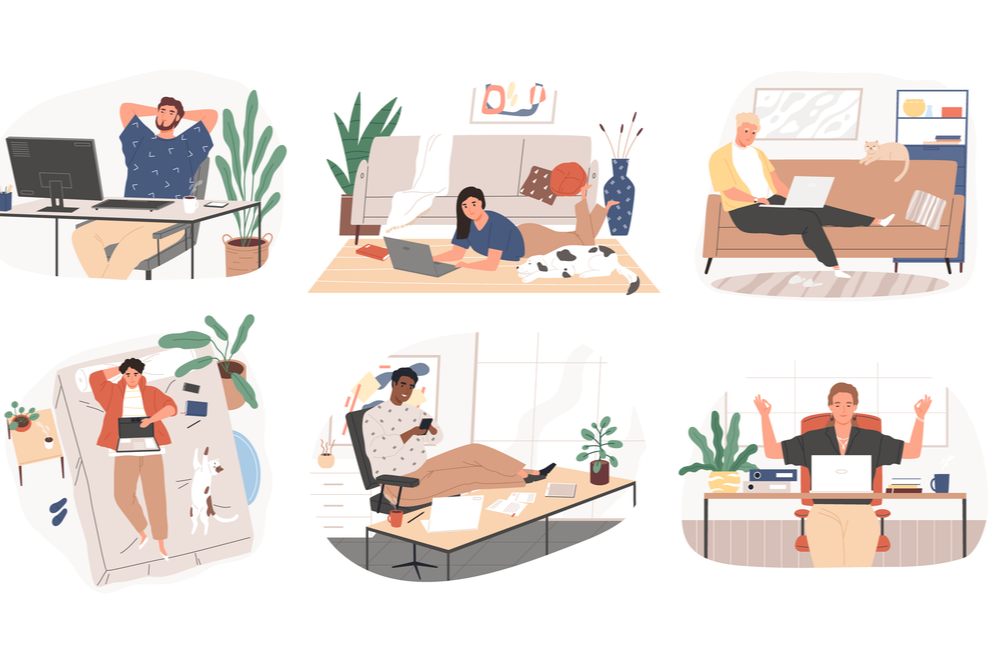Remote working: what's personality got to do with it?
- 6 Min Read
Does personality type affect how we work remotely? John Hackston examines the role that personality type plays in the efficacy of remote work, and how identifying these personality types can help teams to work better without co-location.
- Author: John Hackston
- Date published: May 21, 2020
- Categories

According to the UK Office for National Statistics, almost half of all adults are now working from home. And even when the threat of COVID-19 fades away, it is likely that many of us will continue to be remote workers, as there are financial and other benefits both for businesses and for us as individuals in home working (think of all that time and money previously spent commuting, for example).
Of course, working from home is not all plain sailing. Adjustments need to be made, and rather more fundamental ones than just remembering to tidy up the view behind you on Skype or Zoom. On social media, many have seen a link between lockdown and Introversion. As many tweets have put it, “I’ve been practicing #socialdistancing for most of my life”. But even Introverts will not enjoy home working if the conditions aren’t right, especially when, as with the current crisis, remote working has been suddenly imposed and there are anxieties about friends and family, a loss of face to face social contact, the closure of pubs, cinemas and restaurants, and a lack of clarity about how long this will all last.
Suddenly, it is very important for HR specialists and managers to think about how employees with different attitudes and personality preferences may cope with the stress and uncertainty, and the new realities of working from home.
One of the most popular ways of describing personality is the type approach, as used by the Myers-Briggs Type Indicator® (MBTI®) assessment. This looks at four aspects of personality: whether we prefer to focus our attention on the outside world (Extraversion, E), or on our inner world of thoughts and feelings (Introversion, I); whether we prefer to deal with detailed, concrete information (Sensing, S) or the big picture (Intuition, N); whether we prefer to make decisions on the basis of objective logic (Thinking, T) or on the basis of our values and how people will be affected (Feeling, F); and whether we prefer to live our lives in an ordered, structured way (Judging, J) or in a more open, spontaneous way (Perceiving, P).
In situations like the current crisis, the MBTI model has the advantage of being straightforward enough for people to quickly understand something about their own personality, as well as the personality of other people. Individuals who know and understand their MBTI type can use the framework to help them adapt to virtual working, helped by HR and L&D practitioners. Two aspects of MBTI type are particularly relevant, E-I and J-P.
Extraversion and Introversion (E-I)
People with a preference for Extraversion prefer a busy, lively environment with plenty of opportunities for interaction. This may be difficult to achieve when working from home, especially as the opportunities for social contact outside work are much reduced. It is important for Extraverts to take regular breaks and to make their environment more stimulating, for example by playing music or by getting away from their workspace for a short time. This could be just within their house or flat, or outside; after all, government guidelines suggest that we can exercise outdoors once a day.
Extraverts should make full use of this, but not as an excuse for socialising too closely. Communication is important, and businesses should make use of online tools such as Zoom or Skype and schedule regular informal meetings and virtual get-togethers. Without the formal structures of the office, Extraverts may however need to plan times that are free of distractions if they need to carry out focused work.
Until recently, many Introverts have felt pressured to behave in a more ‘extraverted’ way, and some will appreciate the peace and quiet of the ‘new normal’. They typically enjoy a calm, peaceful environment and might quite enjoy working from home, if there are not too many other people, especially children, around as well. They do however need some contact with the outside world, and it is important that they avoid becoming isolated by engaging and communicating with family, friends, and colleagues. Others should remember to include them too; for some Introverts, there is a danger that they become so engrossed in work or a hobby that they neglect everything else. Taking regular breaks is useful for Introverts too.
Judging and Perceiving (J-P)
People with a Judging preference enjoy a planned, organized life and they may have been very unsettled by the imposed change of suddenly working from home, and the disruption to their routine that this entailed. It will be useful for them to get into a new routine as soon as they can, and important for organizations to facilitate this. This will be particularly relevant where staff have been furloughed, have settled into a new routine, and then are returned to work. Setting clear work and personal goals at the start of each day will be useful, as will setting boundaries around working hours and allowing for other activities, such as shopping, to take longer than before. Where organizations have asked staff to work reduced hours, they should be very clear about exactly what this entails.
For the Perceiving preference, working from home brings both pros and cons. People with this preference may enjoy many aspects of working from home, such as the freedom to be flexible around hours, especially (if they have a garden) when the sun is shining. However, restrictions may make it difficult to be spontaneous and working at home can settle into a routine, which they are likely to find demotivating. Maintaining variety by moving between different activities or between different work projects will help keep them fresh. Informal virtual meetings and get-togethers that have a ‘playful’ character can also be useful.
Whole type – bringing it together
The other aspects of the MBTI model, Sensing-Intuition (S-N) and Thinking-Feeling (T-F), also play a part, especially when it comes to how stressful people will find the current crisis, and the ways in which they are likely to react to this. For example, stripped of the usual cues of face to face contact, the online communication of Thinking individuals can be very direct and task-focused, with terse, impersonal emails or IMs, leaving those with a Feeling preference wondering what they have done wrong. Being aware of other’s needs can reduce stress for both.
The dynamic combination of the four dimensions (E or I, S or N, T or F, J or P) gives 16 different personality types, each with their own reaction to the current uncertain times. You can download tips for each type here, or visit The Myers-Briggs Company remote working page for more information. In the current crisis, it is more important than ever that we do what we can to understand each other.








